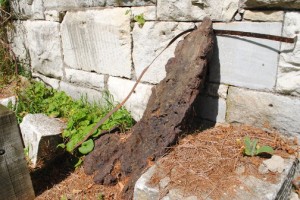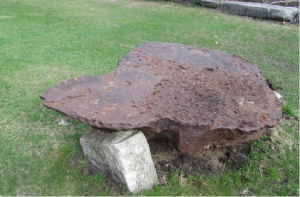I thought this was a blast furnace, not a zoo!
Different kinds of problems at a blast furnace leave different kinds of evidence. Two of them — related, but not the same thing by far — are called by the imaginative names of furnace bear and salamander.
What was a furnace bear?
In the smelting process, occasionally a glob of molten iron would adhere to the inside of the stack. There were ways to deal with the problem when one was detected (they involved men at the top, trying to pry the glob loose from the inside of the stack using 40 foot long iron poles — hazardous and difficult work). However, they didn’t always work, and sometimes the glob hardened and was removed when the furnace was next shut down.

Here’s a furnace bear that was at some time removed from the stack at Beckley. Does this look like a bear climbing a tree to you? It did to the people who worked at the furnace over a century ago!
And how’s that different from a salamander?
Well, if you think of a salamander as the whole hearth of the furnace turning into a congealed disk of iron, unmelted ingredients, and a few bricks from the hearth itself, you would be pretty much correct.
They tended to happen on two different kinds of situations. First, when a furnace was shut down for major maintenance. There was always likely to be some molten iron left in the bottom of the furnace that solidified and created a salamander. The second case was more serious. It occurred when there was a failure somewhere in the smelting process and a whole mass of iron, unmelted/unburned ingredients, and pieces of the furnace floor and wall, congealed into a solid mass.

Here’s a particularly ugly one. We’re told that the furnace had to be partially disassembled to remove a salamander, and that it would take several teams of oxen to pull it out.
No, it doesn’t look like any salamander we’ve ever seen, but evidently it did to the furnace workers of a century and more ago!
